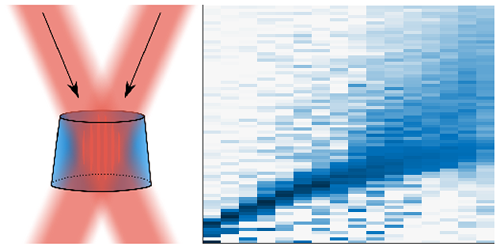New paper "Excitation Spectrum and Superfluid Gap of an Ultracold Fermi Gas" selected as Editors' suggestion in PRL

In a new paper in Physical Review Letters selected as Editors' suggestion, Georg Bruun has together with an experimental group at the University of Hamburg used an ultracold gas of fermionic 6Li atoms to explore the excitation spectrum of a strongly correlated quantum many-body system. For strong attractive interactions, the atoms bind pairwise forming dimers, which condense into a Bose-Einstein condensate (BEC). As the attraction decreases, the dimers become less bound and increase in size, so that they smoothly evolve into so-called Cooper pairs. As a results, the atomic gas becomes a fermionic BCS superfluid in analogy with conventional electronic superconductors. This BEC to BCS transition is a famous and much studied phenomenon in physics, but the associated excitation spectrum has until now remained largely unexplored. The Hamburg group addressed this question using the great flexibility of atomic gases and by comparing with theoretical calculations by Georg Bruun and a collaborator, they were able to identify sound (Goldstone) modes related to the broken symmetry of the system, as well as excitations related to the breaking of individual Cooper pairs. It was found that the measured spectrum agreed very well with theoretical predictions in the BEC and crossover regimes, whereas discrepancies were found towards the BCS regime. Such discrepancies provide important benchmarks for improving our understanding of strongly correlated superfluids, which exist across many energy scales in physics from electrons in crystals, over neutron stars, to quark condensates.
Read the full paper here
